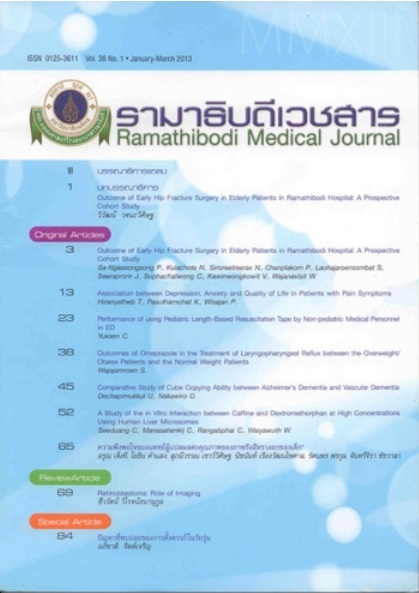Retinoblastoma: Role of Imaging
Keywords:
Imaging, RetinoblastomaAbstract
Retinoblastoma (Rb) is the most common intraocular tumor of childhood, which arises from the immature retina. It may present in hereditary or sporadic form. Children with hereditary Rb present as bilateral disease in 85% of cases and are at risk of trilateral Rb. Progress in management has been made in the past few years with excellent tumor control. Early detection of retinoblastoma is very important as conservative treatment or eye-preserving therapy can be successful. Clinical and imaging studies are very important in Rb because it is one of the few cancers for which treatment decision is made based on findings of the clinical examination and imaging studies without a confirmed histopathologic diagnosis. We herein review retinoblastoma with emphasis on role of imaging.
References
Kivelä T. The epidemiological challenge of the most frequent eye cancer: retinoblastoma, an issue of birth and death. Br J Ophthalmol. 2009;93(9):1129-31. doi:10.1136/bjo.2008.150292.
Broaddus E1, Topham A, Singh AD. Incidence of retinoblastoma in the USA: 1975-2004. Br J Ophthalmol. 2009;93(1):21-3. doi:10.1136/bjo.2008.138750.
Murphree AL, Benedict WF. Retinoblastoma: clues to human oncogenesis. Science. 1984;223(4640):1028-33.
Francke U, Kung F. Sporadic bilateral retinoblastoma and 13q- chromosomal deletion. Med Pediatr Oncol. 1976;2(4):379-85.
Grabowski EF, Abramson DH, Retinoblastoma. In: Fernbach DJ, Vietti TJ, eds. Clinical pediatric oncology. 4th ed. St. Louis: Mosby Year Book. 1991:427-35.
Jakobiec FA, Tso MO, Zimmerman LE, Danis P. Retinoblastoma and intracranial malignancy. Cancer. 1977;39(5):2048-58.
Donaldson SS, Egbert PR, Lee WH. Retinoblastoma. In: Pizzo PA, Poplack DG, eds. Principles and practice of pediatric oncology. 2nd ed. Philadelphia: JB Lippincott. 1993:683-96.
Ts'o MO, Fine BS, Zimmerman LE, Fine BS. The nature of retinoblastoma. II. Photoreceptor differentiation: An electron microscopic study. Am J Opthalmol. 1970;69:350-9.
Zimmerman LE. Retinoblastoma and retinocytoma. In: Spencer WH, ed. Ophthalmicpathology: An Atlas and textbook, 3rd ed. vol 2. Philadelphia: WB Saunders. 1985:1292-351.
Lee W-H, Bookstein R, Lee YH-P. Molecular biology of the human retinoblastoma gene. In: Klein G, ed. Tumor suppressor genes. New York: Marcel Dekker. 1990:169-200.
Chen JA, O’brien JM. Current management of retinoblastoma. In: Albert DM, Jacobiec FA, eds. Principles and Practice of Opthalmol. 2006;17:228-34.
Reese AB, Ellsworth RM. The evaluation and current concept of retinoblastoma therapy. Trans Am Acad Ophthalmol Otolaryngol. 1963;67:164-72.
Shields CL, Shields JA. Basic understanding of current classification and management of retinoblastoma. Curr Opin Ophthalmol. 2006;17(3):228-34.
Chantada G, Doz F, Antoneli CB, et al. A proposal for an international retinoblastoma staging system. Pediatr Blood Cancer. 2006;47(6):801-5.
Kaste SC, Jenkins JJ 3rd, Pratt CB, Langston JW, Haik BG. Retinoblastoma: sonographic findings with pathologic correlation in pediatric patients. AJR Am J Roentgenol. 2000;175(2):495-501.
Galluzzi P, Hadjistilianou T, Cerase A, De Francesco S, Toti P, Venturi C. Is CT still useful in the study protocol of retinoblastoma?. AJNR Am J Neuroradiol. 2009;30(9):1760-5. doi: 10.3174/ajnr.A1716.
Roth DB, Scott IU, Murray TG, et al. Echography of retinoblastoma: histopathologic correlation and serial evaluation after globe-conserving radiotherapy or chemotherapy. J Pediatr Ophthalmol Strabismus. 2001 May-Jun;38(3):136-43.
Beets-Tan RG, Hendriks MJ, Ramos LM, Tan KE. Retinoblastoma: CT and MRI. Neuroradiology. 1994;36(1):59-62.
Brisse HJ, Guesmi M, Aerts I, et al. Relevance of CT and MRI in retinoblastoma for the diagnosis of postlaminar invasion with normal-size optic nerve: a retrospective study of 150 patients with histological comparison. Pediatr Radiol. 2007;37(7):649-56.
Kaufman LM, Mafee MF, Song CD. Retinoblastoma and simulating lesions. Role of CT, MR imaging and use of Gd-DTPA contrast enhancement. Radiol Clin North Am. 1998;36(6):1101-17.
Manschot WA. Persistent hyperplastic primary vitreous; special reference to preretinal glial tissue as a pathological characteristic and to the development of the primary vitreous. AMA Arch Ophthalmol. 1958;59(2):188-203.
Goldberg MF. Persistent fetal vasculature (PFV): an integrated interpretation of signs and symptoms associated with persistent hyperplastic primary vitreous (PHPV). LIV Edward Jackson Memorial Lecture. Am J Ophthalmol. 1997;124(5):587-626.
Haik BG. Advanced Coats' disease. Trans Am Ophthalmol Soc. 1991;89:371-476.
Shields JA. Ocular toxocariasis. A review. Surv Ophthalmol. 1984;28(5):361-81.













